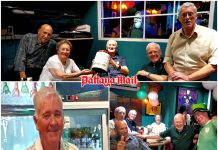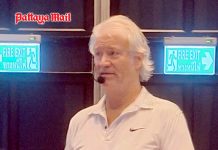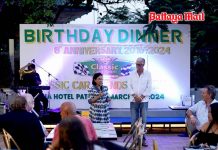There are several reasons for having plastic surgery. Some are done for reconstructive purposes, usually after someone has been involved in an accident. Other reasons include enhancing beauty and hiding the effects of aging on the skin. Dr. Dulayanat (Ping) Aranyapala, from Phyathai Sriracha Hospital, spoke to the Pattaya City Expats Club at their Sunday, March 15, meeting describing these reasons and the various techniques used to achieve these purposes.
Dr. Ping specializes in minimally invasive plastic surgery. His training and experience includes General Surgery Resident at Prince of Songkla University, Fellowship of Plastic Surgery at Siriraj Hospital, Plastic Surgeon at Prince of Songkla University, Fellowship in Minimal Invasive Surgery at Image Plastic Surgery in Seoul S. Korea, and Plastic Surgeon Phyathai Sriracha Hospital.
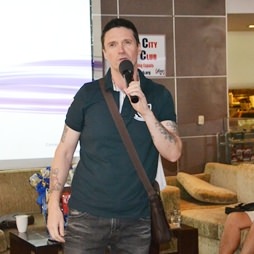 PCEC member Gavin Waddell, International Marketing Executive for Phyathai Hospital Sriracha, introduces Dr. Dulayanat (Ping) Aranyapala.
PCEC member Gavin Waddell, International Marketing Executive for Phyathai Hospital Sriracha, introduces Dr. Dulayanat (Ping) Aranyapala.
In Korea, where he received his Fellowship, he commented that in families that can afford it, almost all young teenage girls undergo plastic surgery to make them more attractive; some even dream of becoming movie stars. Dr. Ping said that to be done properly, plastic surgery has to be performed by a surgeon. When not done that way, the results can be horrific. There are instances of people dying during treatment and of people committing suicide after they saw the results of a botched operation.
When doing plastic surgery for aesthetic reasons, Dr. Ping explained the key is for the doctor and the patient to set a goal for what they want to achieve. Further, Asians and Caucasians often have different goals. For aesthetic plastic surgery, Dr. Ping described the “golden ratio,” which is a mathematical formula that has long been applied to designs to make them more attractive. It refers to the relationship between two sections of a design. Many surgeons apply this concept to their plastic surgery.
Dr. Ping recommends that non-invasive techniques be used as much as possible. On its website, the American Society of Plastic Surgery identifies the “top five” cosmetic minimally invasive procedures used in 2013 as follows: Botulinum toxin type A (6.3 million procedures), Soft tissue fillers (2.2 million), Chemical peel (1.2 million), Laser hair removal (1.1 million), and Microdermabrasion (970,000).
Botulinum toxin type A (brand name: Botox) is made from the bacteria that causes botulism and so has to be used very carefully. Chemical peel involves using a chemical solution to smooth the texture of the skin by removing the damaged outer layers. Microdermabrasion is a skin-care technique that uses tiny rough grains to buff away the surface layer of skin.
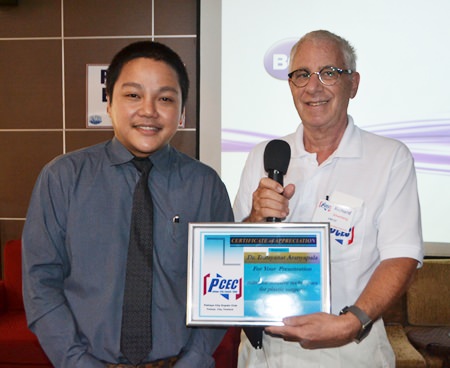 MC Richard Silverberg presents the PCEC’s Certificate of Appreciation to Dr. Ping.
MC Richard Silverberg presents the PCEC’s Certificate of Appreciation to Dr. Ping.
Dr. Ping mentioned that facelifts, on the other hand, are surgical procedures and can cause complications. These include side effects such as pain, numbness and puffing. For most people, these side effects are transitory, but that is not true for everyone. More importantly, facelifts tend to lose their value after 10 years, and so additional surgeries are often required.
Liposuction is also a surgical procedure. It involves the removal of fat deposits using a tube inserted beneath the skin. It is the most popular type of cosmetic surgery in the United States.
Dr. Ping described a technique called “blepharoplasty,” which involves correcting defects, deformities and disfigurations of the eyelids; or aesthetically modifying the eye region of the face. Dr. Ping said that there is also a new procedure that involves hooking the eyebrows up.
He explained another procedure, called “browplasty” or “forehead lift,” which is used to elevate a drooping eyebrow that may obstruct vision or to remove the deep “worry” lines that run across the forehead. He further described “tummy tuck” surgery, also known as “abdominoplasty,” which involves removing excess fat and skin and, in most cases, restoring weakened or separated muscles to create an abdominal profile that is smoother and firmer. Dr. Ping said that liposuction and abdominoplasty are often done together in one operation.
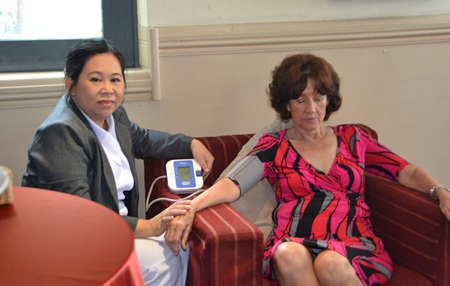 PCEC members and guests take advantage of free blood pressure checks offered by Phyathai Hospital.
PCEC members and guests take advantage of free blood pressure checks offered by Phyathai Hospital.
Dr. Ping also mentioned endoscopic surgery, also known as “endoscopy,” one of the newest plastic surgery techniques. It allows surgeons to operate with fewer conspicuous incisions, reducing obvious scars. It has been used in orthopedic surgery, urology and gynecology for decades. Improvements in technology have enabled plastic surgeons to use endoscopy for many cosmetic procedures, including facelifts, forehead lifts, abdominoplasty, and breast augmentation. Endoscopy can also be used in some reconstructive procedures. In many cases, the use of endoscopy results in shorter recovery times.
After the presentation, MC Richard Silverberg brought everyone up to date on upcoming events and called on Roy Albiston to conduct the Open Forum, where questions are asked and answered about Expat living in Thailand, especially Pattaya.
For more information on the PCEC’s many activities, visit their website at www. pcecclub.org.
After the meeting, Ren Lexander interviewed Dr. Ping for Pattaya Mail TV. To view the interview, visit: https://www.youtube.com/watch?v=wUpK6v2sfJs


